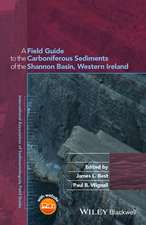Chemical Petrology: with applications to The Terrestrial Planets and Meteorites
Autor R. F. Mueller, S. K. Saxenaen Limba Engleză Paperback – 22 noi 2011
Preț: 409.51 lei
Nou
Puncte Express: 614
Preț estimativ în valută:
78.36€ • 82.02$ • 65.22£
78.36€ • 82.02$ • 65.22£
Carte tipărită la comandă
Livrare economică 31 martie-14 aprilie
Preluare comenzi: 021 569.72.76
Specificații
ISBN-13: 9781461298915
ISBN-10: 1461298911
Pagini: 394
Ilustrații: 394 p.
Dimensiuni: 210 x 280 x 30 mm
Greutate: 0.92 kg
Ediția:Softcover reprint of the original 1st ed. 1977
Editura: Springer
Colecția Springer
Locul publicării:New York, NY, United States
ISBN-10: 1461298911
Pagini: 394
Ilustrații: 394 p.
Dimensiuni: 210 x 280 x 30 mm
Greutate: 0.92 kg
Ediția:Softcover reprint of the original 1st ed. 1977
Editura: Springer
Colecția Springer
Locul publicării:New York, NY, United States
Public țintă
ResearchCuprins
1 Energetic basis.- General relations.- Equations of state and chemical potential of pure gases, liquids, and solids.- Phases of variable composition.- Reactions and equations of equilibrium.- The Gibbs phase rule.- Effect of gravitational field.- Kinetics.- 2 Equilibrium of mineral systems.- One-component transitions.- Univariant transformations of solids.- Univariant reactions involving gases.- The system CaO-MgO-CO2.- Exchange equilibria.- The distribution of minor elements.- Coupled equilibria involving solid solutions and gases.- Intrinsic and extrinsic stability.- Ionic processes.- Crystal-melt equilibria.- 3 Kinetics of mineral systems.- General.- Quasiequilibrium processes in a temperature gradient.- Quasiequilibrium processes under isothermal conditions.- Crystal kinetics.- Kinetics of dissociation.- Kinetics of complex heterogeneous reactions.- Kinetics of rock deformation.- 4 Classifications of rocks.- Chemical classification.- Mineral facies classification.- 5 Chemical and petrogenetic processes in space.- Solids in space.- The problem of the origin of the solar system.- Condensation from a gas of solar composition.- The effect of nonequilibrium ionization.- System O-Si-Mg-Fe-Ni-P.- 6 Meteorites.- General characteristics.- The dating of events in meteorite history.- Classification schemes.- Mineralogy.- Petrography of the chondrites.- Bulk chemical characteristics.- Prior’s rules.- Oxidation and hydration states of meteorites.- Carbon reactions in meteorites.- Reactions involving sulfur and phosphorus compounds in meteorites.- Element distributions in meteorites.- Mechanisms of liquidus crystallization for the chondrites.- Origin of the metallic components of chondrites.- Pressure of formation of meteorites.- Origin of meteorites: a critique of theoriesand hypotheses.- 7 The terrestrial planets.- Gross physical and chemical characteristics.- Origin and evolution.- Chemistry and petrology of Venus.- The atmosphere and surface of Mercury.- Mars.- The Moon.- Comparative planetology.- 8 Metamorphism and metamorphic mechanisms.- Origin of microstructures and textures.- Kinetic aspects of crystallization.- Rates of metamorphic reactions.- Mineral orientation.- Origin of macrostructures.- Origin of compositional variations.- Summary.- 9 Metamorphic minerals.- Experimental appraisal of the stability of minerals.- Theoretical analysis of stabilities of crystalline solutions.- 10 Metamorphic mineral facies.- Diagenesis and metamorphism; the zeolite and lawsonite facies.- Greenschist facies.- Amphibolite facies.- Granulite facies.- 11 Experimental and theoretical study of metamorphic systems.- Geometric analysis of phase equilibria.- Method of interpreting metamorphic assemblages.- The system K2O-MgO-Al2O3-SiO2-H2O.- Assemblages with staurolite.- The system SiO2-K2O-Al2O3-FeO-MgO-H2O in transition from amphibolite to granulite facies.- Anthophyllite-gedrite pelitic rocks.- The system CaO-Al2O3-SiO2-H2O.- Assemblages with cordierite in the granulite facies.- The charnockite assemblage.- Magnesian, calcic, and carbonate rocks.- Metamorphism of ultramafic rocks.- The iron formations.- Rocks of high pressure and controversial origin.- 12 Properties, origin, and environment of magmas.- Structures of silicate melts.- Solubilities of volatile components.- Densities of magmas.- Viscosities of magmas.- Liquid Immiscibility.- Origin of magmas.- General features of the occurence of magmatic rocks.- 13 Differentiation and crystallization of magmas.- The existence of rock series and their meaning.- Homogeneous differentiation.- Heterogeneous differentiation by separation of a fluid phase.- Separation of a fluid phase in a crystallizing magma.- Crystallization and heterogeneous differentiation in magmas.- Subtraction and variation diagrams.- 14 Igneous plutons: Their physical chemistry and mode of occurrence.- The compositional fields of igneous rocks.- General factors in the differentiation of basaltic magmas.- Differentiated gabbroic complexes.- Large calc-alkali plutonic complexes.- The physical chemistry of calc-alkaline-type differentiation.- Origin of calc-alkali magmas.- Alkaline rocks.- Assimilation and alteration of inclusions.- Structural environment and mode of emplacement of igneous plutons.- Plutonic rocks of complex origin.- 15 Volcanism and volcanic fluids.- Volcanic and hypabyssal mineralogy.- Volcanoes and volcanic deposits.- Volcanic fluids.- References.- Author Index.











